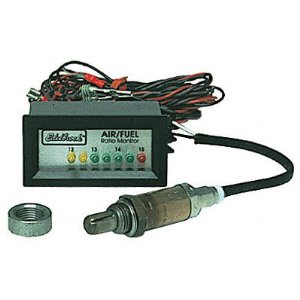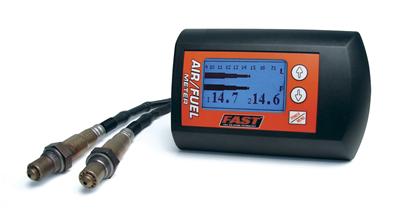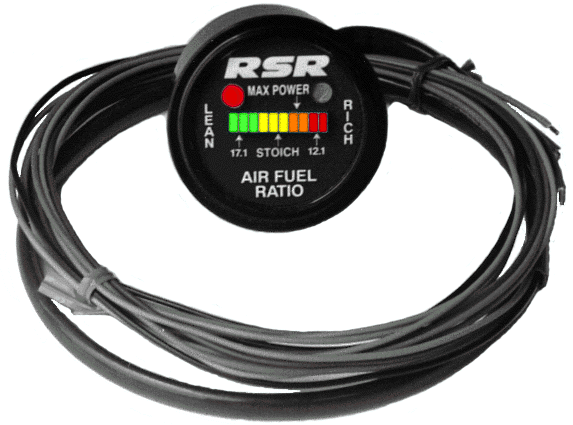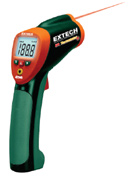Before there was a/f ratio meters there were mechanics that had years of experience reading spark plug condition as a good indicator of what the combustion chamber temps and conditions were,and while its true that reading spark plugs is an art that needs experience to master,
this threads links will help,
viewtopic.php?f=70&t=202
http://www.chevyhiperformance.com/tech/ ... index.html
http://garage.grumpysperformance.com/index.php?threads/setting-up-your-fuel-system.211/
http://garage.grumpysperformance.com/index.php?threads/how-big-a-fuel-pump-do-you-need.1939/
http://garage.grumpysperformance.com/index.php?threads/fuel-pressure-regulators.635/
http://garage.grumpysperformance.com/index.php?threads/carb-tuning-info-and-links.109/
http://garage.grumpysperformance.com/index.php?threads/so-you-failed-emmision-testing.3522/
http://garage.grumpysperformance.co...ning-with-an-air-fuel-logger.6765/#post-25598
http://garage.grumpysperformance.com/index.php?threads/air-fuel-meters-and-tuning.268/#post-18435
reading the links and sub links will help
and that takes time,time you might not want to invest, so technology give you an option that will allow you to get good info far faster, and reading plugs certainly is not able to give the exact info that a a/f ratio gauge and an o2 sensor can give you, if you want to learn a good deal faster and get more exact answers the use of a fuel/air meter can certainly be a huge help, that doesn,t suggest you can ignore reading plugs, but it sure is a recommendation to get a f/a meter and learn how to use it.
the meter I use is no longer made and its not the best available as theres been constant upgrades in the technology, Im reluctant to suggest any brand simply because the technology is advancing and prices dropping as time passes
but the innovatemotorsports is the meter I see most commonly in shops
heres a few selections, and related info
http://www.rpmoutlet.com/autowb.htm
http://www.carcraft.com/techarticles/11 ... index.html
http://www.summitracing.com/parts/CCA-170402/?rtype=10
http://www.turborick.com/air1.html
http://www.innovatemotorsports.com/products/lm2.php
http://www.moates.net/product_info.php? ... ucts_id=54
http://www.airfuelratiometer.com/
http://www.summitracing.com/parts/CCA-170401
http://ljs.academicdirect.org/A14/031_049.htm
http://www.egauges.com/pdf/AutoMeter/837j.pdf
http://www.rbracing-rsr.com/rsrgauge.htm
http://www.airfuelmeter.com/english/lsu4_en_sensor.htm
http://www.summitracing.com/search/?key ... eter&dds=1
http://www.jegs.com/webapp/wcs/stores/s ... atio+meter
http://www.zeitronix.com/order/order.htm
http://www.airfuelmeter.com/english/
http://thedynoshop.net/prod01.htm
http://neptune.spacebears.com/cars/stor ... gauge.html
for those guys with some electrical fabrication skills
http://www.scirocco.org/tech/misc/afgauge/af.html
http://www.aces.edu/~parmega/efi/temp/wb/guide.html
http://www.redline.lt/magazine/spec-fea ... icle/17/1/
https://www.msu.edu/~levesqu6/airfuel.htm
it certainly won,t hurt to have access to a fuel/air gauge
Edelbrock 6593 Air/Fuel Ratio Gauge

http://www.summitracing.com/parts/EDL-6593/
fast air fuel gauge

http://www.summitracing.com/parts/FST-170402/?rtype=10
rsr air fuel gauge

http://www.rbracing-rsr.com/rsrgauge.htm
http://www.competitiondata.com/air_fuel ... _vs_nb.htm
If you do a little research you will find lots of “Air/Fuel Meters†on the market priced in the $100 to $ 400 range. These are “narrow band†products based on production car Oxygen or Lambda sensors. You will also find products priced at $ 1000 to $ 4000 per channel and even higher. These are wide band products.
What’s the Difference?
Wide Band
* Shows Actual Air/Fuel ratio.
* Precise display of ratio on the rich side of “stoichiometricâ€, which is where all performance engines run. Usually displays Air /Fuel ratio to the second decimal place.
* Useful for maximizing power from race and other performance engines.
* Fully temperature compensated.
* Higher cost.
Narrow Band
* Shows indication of rich vs lean.
* Usually has very “coarse†display of ratio on the rich side of “stoichiometric. Some units only have 2 LEDs for the entire rich range!
* Really only useful for making sure your engine is not running on the lean side.
* Usually not temperature compensated, so the same air/fuel condition in the motor will result in an indication on the meter that will vary depending on sensor temperature.
* Low cost.
Bottom Line:
If you are a builder or tuner of performance engines who needs to maximize performance of the engines you work with, then you need to be measuring Air/Fuel ratio with a wide band meter.
If you simply want an indication that you are rich or lean to make sure you are not going to burn the motor up, you can get by with a narrow band meter
Narrow Band vs. Wide Band Air Fuel Ratio Meter
An air fuel ratio meter is a type of gauge that is used in cars, boats or any vehicle that has an internal combustion engine. Its job is to detect how much voltage is emitted by the engine’s oxygen sensor, and in so doing, it can gauge the engine’s air-fuel ratio. Air fuel ratio meters are important because they help to ensure that your vehicle is using fuel efficiently, helps your catalytic converter to work optimally and thus cuts down on toxic emissions, and maximizes the engine’s performance in general. Nowadays, there are 2 types of air fuel ratio meters on the market: narrow-band readers, and wide-band readers. Keep reading to find out how the two are different, and their pros and cons.
Narrow Band vs. Wide Band Air Fuel Ratio Meter: Physical Qualities
The narrow band meter has long been the standard in cars, although now it’s becoming a bit antiquated. They are present in your car in a round-shaped housing. Like the other gauges in your car, the mounting usually measures in either 2 1/16 inch diameter or 2 5/8 inch diameter, with 10 to 20 LEDs. Some are available with a needle-style gauge interface. The reliability of the narrow band meter can be negatively affected by increasing gas temperatures, so they have to be used with care.
www. Siemens. com/ Air_Flowmeters
Wide band meters are newer and more accurate. They can either stand alone or be mounted in round housings also. Unlike the narrow band meters, these have a numeric display, and can display much more sensitive and accurate information. They have a linear output of 0 to 5 V and can function no matter what the temperature of your car’s engine.
Narrow Band vs. Wide Band Air Fuel Ratio Meters: Which One Should I Use?
If you have an older car that you just need to check on from time to time, especially if you suspect that something might be wrong with the oxygen sensor, then a plain old narrow band reader will probably do just fine. These models are cheaper, and as long as you’re not worried about getting a very sensitive reading, then the narrow band should do just fine.
On the other hand, if it’s your treasured sports car that we’re talking about, or if you need to perform some really sensitive, highly refined maintenance, then you should really spring for the wide band meter. The wide band meter gives you more accurate information, gives you more precise numbers, is reliable no matter the temperature and is easier to read. If you feel that there’s a lot at stake for the health of your car, then, it’s worth the extra investment in a wide band air fuel ratio meter.
keep in mind an IR temp gun will tend to read the front exhaust ports a bit lower in temperature than the rear cylinders simply because of the increase in cooler air flow surrounding them first while heated air reaches the rear two cylinders, and some internal coolant flow , is routed past those front two cylinders on each bank,and back to the radiator without making the trip thru the whole blocks cooling passages,thus they will tend to be cooler, so its not all that rare for the front two cylinders on each bank to run 20 geg-50 deg cooler, but remember your looking for major differences in cylinder temps. which tend to indicate non firing cylinders, really lean or rich fuel/air ratios or ignition miss fires[/b]

http://www.professionalequipment.com/ex ... ermometer/
Read more: http://www.doityourself.com/stry/narrow ... z104zOE8IJ
Read more: http://www.doityourself.com/stry/narrow ... z104z4RvcZ
read these links below
http://autospeed.com/cms/title_InCar-Ai ... ticle.html
http://autospeed.com.au/cms/article.html?&A=2191
this threads links will help,
viewtopic.php?f=70&t=202
http://www.chevyhiperformance.com/tech/ ... index.html
http://garage.grumpysperformance.com/index.php?threads/setting-up-your-fuel-system.211/
http://garage.grumpysperformance.com/index.php?threads/how-big-a-fuel-pump-do-you-need.1939/
http://garage.grumpysperformance.com/index.php?threads/fuel-pressure-regulators.635/
http://garage.grumpysperformance.com/index.php?threads/carb-tuning-info-and-links.109/
http://garage.grumpysperformance.com/index.php?threads/so-you-failed-emmision-testing.3522/
http://garage.grumpysperformance.co...ning-with-an-air-fuel-logger.6765/#post-25598
http://garage.grumpysperformance.com/index.php?threads/air-fuel-meters-and-tuning.268/#post-18435
reading the links and sub links will help
and that takes time,time you might not want to invest, so technology give you an option that will allow you to get good info far faster, and reading plugs certainly is not able to give the exact info that a a/f ratio gauge and an o2 sensor can give you, if you want to learn a good deal faster and get more exact answers the use of a fuel/air meter can certainly be a huge help, that doesn,t suggest you can ignore reading plugs, but it sure is a recommendation to get a f/a meter and learn how to use it.
the meter I use is no longer made and its not the best available as theres been constant upgrades in the technology, Im reluctant to suggest any brand simply because the technology is advancing and prices dropping as time passes
but the innovatemotorsports is the meter I see most commonly in shops
heres a few selections, and related info
http://www.rpmoutlet.com/autowb.htm
http://www.carcraft.com/techarticles/11 ... index.html
http://www.summitracing.com/parts/CCA-170402/?rtype=10
http://www.turborick.com/air1.html
http://www.innovatemotorsports.com/products/lm2.php
http://www.moates.net/product_info.php? ... ucts_id=54
http://www.airfuelratiometer.com/
http://www.summitracing.com/parts/CCA-170401
http://ljs.academicdirect.org/A14/031_049.htm
http://www.egauges.com/pdf/AutoMeter/837j.pdf
http://www.rbracing-rsr.com/rsrgauge.htm
http://www.airfuelmeter.com/english/lsu4_en_sensor.htm
http://www.summitracing.com/search/?key ... eter&dds=1
http://www.jegs.com/webapp/wcs/stores/s ... atio+meter
http://www.zeitronix.com/order/order.htm
http://www.airfuelmeter.com/english/
http://thedynoshop.net/prod01.htm
http://neptune.spacebears.com/cars/stor ... gauge.html
for those guys with some electrical fabrication skills
http://www.scirocco.org/tech/misc/afgauge/af.html
http://www.aces.edu/~parmega/efi/temp/wb/guide.html
http://www.redline.lt/magazine/spec-fea ... icle/17/1/
https://www.msu.edu/~levesqu6/airfuel.htm
it certainly won,t hurt to have access to a fuel/air gauge
Edelbrock 6593 Air/Fuel Ratio Gauge

http://www.summitracing.com/parts/EDL-6593/
fast air fuel gauge

http://www.summitracing.com/parts/FST-170402/?rtype=10
rsr air fuel gauge

http://www.rbracing-rsr.com/rsrgauge.htm
http://www.competitiondata.com/air_fuel ... _vs_nb.htm
If you do a little research you will find lots of “Air/Fuel Meters†on the market priced in the $100 to $ 400 range. These are “narrow band†products based on production car Oxygen or Lambda sensors. You will also find products priced at $ 1000 to $ 4000 per channel and even higher. These are wide band products.
What’s the Difference?
Wide Band
* Shows Actual Air/Fuel ratio.
* Precise display of ratio on the rich side of “stoichiometricâ€, which is where all performance engines run. Usually displays Air /Fuel ratio to the second decimal place.
* Useful for maximizing power from race and other performance engines.
* Fully temperature compensated.
* Higher cost.
Narrow Band
* Shows indication of rich vs lean.
* Usually has very “coarse†display of ratio on the rich side of “stoichiometric. Some units only have 2 LEDs for the entire rich range!
* Really only useful for making sure your engine is not running on the lean side.
* Usually not temperature compensated, so the same air/fuel condition in the motor will result in an indication on the meter that will vary depending on sensor temperature.
* Low cost.
Bottom Line:
If you are a builder or tuner of performance engines who needs to maximize performance of the engines you work with, then you need to be measuring Air/Fuel ratio with a wide band meter.
If you simply want an indication that you are rich or lean to make sure you are not going to burn the motor up, you can get by with a narrow band meter
Narrow Band vs. Wide Band Air Fuel Ratio Meter
An air fuel ratio meter is a type of gauge that is used in cars, boats or any vehicle that has an internal combustion engine. Its job is to detect how much voltage is emitted by the engine’s oxygen sensor, and in so doing, it can gauge the engine’s air-fuel ratio. Air fuel ratio meters are important because they help to ensure that your vehicle is using fuel efficiently, helps your catalytic converter to work optimally and thus cuts down on toxic emissions, and maximizes the engine’s performance in general. Nowadays, there are 2 types of air fuel ratio meters on the market: narrow-band readers, and wide-band readers. Keep reading to find out how the two are different, and their pros and cons.
Narrow Band vs. Wide Band Air Fuel Ratio Meter: Physical Qualities
The narrow band meter has long been the standard in cars, although now it’s becoming a bit antiquated. They are present in your car in a round-shaped housing. Like the other gauges in your car, the mounting usually measures in either 2 1/16 inch diameter or 2 5/8 inch diameter, with 10 to 20 LEDs. Some are available with a needle-style gauge interface. The reliability of the narrow band meter can be negatively affected by increasing gas temperatures, so they have to be used with care.
www. Siemens. com/ Air_Flowmeters
Wide band meters are newer and more accurate. They can either stand alone or be mounted in round housings also. Unlike the narrow band meters, these have a numeric display, and can display much more sensitive and accurate information. They have a linear output of 0 to 5 V and can function no matter what the temperature of your car’s engine.
Narrow Band vs. Wide Band Air Fuel Ratio Meters: Which One Should I Use?
If you have an older car that you just need to check on from time to time, especially if you suspect that something might be wrong with the oxygen sensor, then a plain old narrow band reader will probably do just fine. These models are cheaper, and as long as you’re not worried about getting a very sensitive reading, then the narrow band should do just fine.
On the other hand, if it’s your treasured sports car that we’re talking about, or if you need to perform some really sensitive, highly refined maintenance, then you should really spring for the wide band meter. The wide band meter gives you more accurate information, gives you more precise numbers, is reliable no matter the temperature and is easier to read. If you feel that there’s a lot at stake for the health of your car, then, it’s worth the extra investment in a wide band air fuel ratio meter.
keep in mind an IR temp gun will tend to read the front exhaust ports a bit lower in temperature than the rear cylinders simply because of the increase in cooler air flow surrounding them first while heated air reaches the rear two cylinders, and some internal coolant flow , is routed past those front two cylinders on each bank,and back to the radiator without making the trip thru the whole blocks cooling passages,thus they will tend to be cooler, so its not all that rare for the front two cylinders on each bank to run 20 geg-50 deg cooler, but remember your looking for major differences in cylinder temps. which tend to indicate non firing cylinders, really lean or rich fuel/air ratios or ignition miss fires[/b]

http://www.professionalequipment.com/ex ... ermometer/
Read more: http://www.doityourself.com/stry/narrow ... z104zOE8IJ
Read more: http://www.doityourself.com/stry/narrow ... z104z4RvcZ
read these links below
http://autospeed.com/cms/title_InCar-Ai ... ticle.html
http://autospeed.com.au/cms/article.html?&A=2191
Last edited by a moderator:
